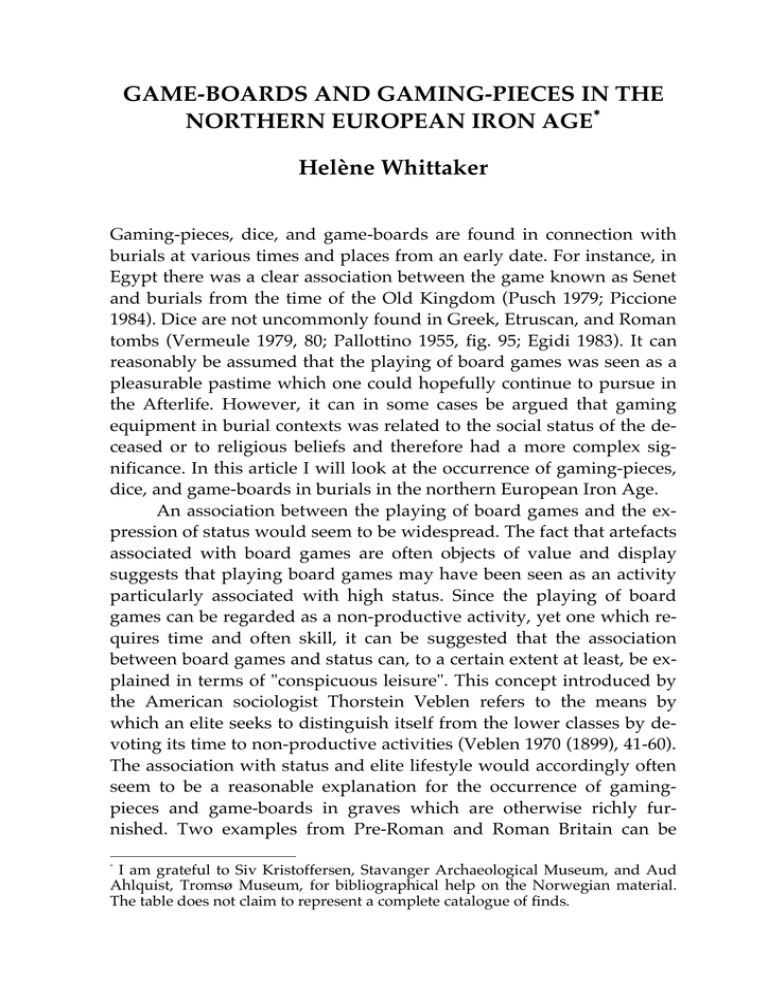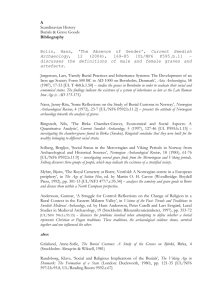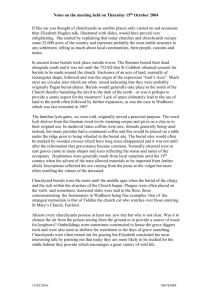game-boards and gaming-pieces in the northern european iron age
advertisement

GAME-BOARDS AND GAMING-PIECES IN THE ∗ NORTHERN EUROPEAN IRON AGE Helène Whittaker Gaming-pieces, dice, and game-boards are found in connection with burials at various times and places from an early date. For instance, in Egypt there was a clear association between the game known as Senet and burials from the time of the Old Kingdom (Pusch 1979; Piccione 1984). Dice are not uncommonly found in Greek, Etruscan, and Roman tombs (Vermeule 1979, 80; Pallottino 1955, fig. 95; Egidi 1983). It can reasonably be assumed that the playing of board games was seen as a pleasurable pastime which one could hopefully continue to pursue in the Afterlife. However, it can in some cases be argued that gaming equipment in burial contexts was related to the social status of the deceased or to religious beliefs and therefore had a more complex significance. In this article I will look at the occurrence of gaming-pieces, dice, and game-boards in burials in the northern European Iron Age. An association between the playing of board games and the expression of status would seem to be widespread. The fact that artefacts associated with board games are often objects of value and display suggests that playing board games may have been seen as an activity particularly associated with high status. Since the playing of board games can be regarded as a non-productive activity, yet one which requires time and often skill, it can be suggested that the association between board games and status can, to a certain extent at least, be explained in terms of "conspicuous leisure". This concept introduced by the American sociologist Thorstein Veblen refers to the means by which an elite seeks to distinguish itself from the lower classes by devoting its time to non-productive activities (Veblen 1970 (1899), 41-60). The association with status and elite lifestyle would accordingly often seem to be a reasonable explanation for the occurrence of gamingpieces and game-boards in graves which are otherwise richly furnished. Two examples from Pre-Roman and Roman Britain can be I am grateful to Siv Kristoffersen, Stavanger Archaeological Museum, and Aud Ahlquist, Tromsø Museum, for bibliographical help on the Norwegian material. The table does not claim to represent a complete catalogue of finds. ∗ Game-boards and gaming-pieces in funerary contexts mentioned. In a burial at Welwyn Garden City in Hertfordshire dated towards the end of the first century BC, the association between status and the playing of board games would seem clearly documented by a set of twenty-four gaming-pieces made of coloured glass which represent rare imported items (Society of Antiquaries of London 1967, 1419). At Lullingstone in Kent, in the vicinity of the Roman villa, a subterranean chamber beneath a temple of Romano-Celtic plan contained two burials (Wright 1959, 132-133). The structure as a whole may therefore have been some kind of mausoleum rather than a sanctuary for the worship of a deity. The elite nature of the burials was further indicated by the grave goods which included bronze and glass vessels. On the head of one of the coffin lids were the carbonised remains of a wooden game-board with bronze fittings as well as a set of thirty gaming-pieces made of white and brown glass. Gaming-pieces for some kind of board game are quite common in Scandinavian tombs of the Iron Age and later periods (Petersen 1914). They have commonly been regarded as evidence for the importance of board games as a way of passing free time in daily life. In those cases where artefacts associated with board games represent rare imported items and have been found in graves which are otherwise rich in grave goods, their occurrence has been associated with elite expression. One of the richest Norwegian graves from the Roman Iron Age was excavated at Avaldsnes in western Norway. Among the grave goods were thirty-one large gaming-pieces made of glass (Solberg 2000, 119-120). An exceptionally rich grave from the eight century, also at Avaldsnes (Storhaug), contained two sets of gamingpieces, one made of glass and the other of amber (Opedal 1998, 53-55). Gaming-pieces made of glass or amber have rarely been found in Norway in Iron Age contexts. As the gaming-pieces found in the burials at Avaldsnes must have been imported from Denmark or the Continent, they are likely to have been considered objects of exceptional value. An association with the expression of status would therefore seem very clear. Several of the richly furnished boat-graves at Valsgärde in Central Sweden dating to the Vendel period (Later Iron Age) and the Viking Age contained gaming-pieces, dice, as well as the remains of wooden game-boards, confirming the association between status and the playing of board games in the Scandinavian Iron Age (Arwidsson 104 Helène Whittaker 1942; Eadem 1954; Eadem 1977). The gaming-pieces from Graves 6, 7, and 8 dating to the Vendel period were made of bone as were the ones from Grave 1 dating to the Viking period. The gaming-pieces from Grave 3 dating to the Viking period were, however, made of glass and must have represented valuable imported items. Gaming-pieces were also found in the nearby boat-graves at Vendel and at Tuna in Alsike (Stolpe & Arne 1912; Arne 1934). Noteworthy are the glass gamingpieces from a destroyed grave (Inventory number 9404) at Tuna in Alsike, which the excavators suggest may have been imported from the Rhine area. Similar gaming-pieces have been found at Birka (Graves 644, 750) as well as in Russia (Arne 1934, 58-59). Further conclusions concerning the associations between board games and status in Iron Age Scandinavia can be drawn. It is interesting that the gaming-pieces and game-boards seem to be particularly associated with high status male burials. Concerning the Storhaug burial at Avaldsnes, it was not possible to determine the sex of the buried individual from the skeletal material; however, as the grave contained an exceptionally large number of weapons, it is virtually certain that the burial was that of a high-status man (Opedal 1998, 6263). At Valsgärde, game-boards and gaming-pieces were exclusively associated with the male burials. It is noteworthy that in contrast, no game-boards or gaming-pieces were found in the funerary equipment of the rich female boat-burials at Tuna in Badelunda, also in Central Sweden (Nylén & Schönbeck 1994). In the Viking period game-boards and gaming-pieces occur quite frequently in high status male burials and can almost be considered part of the necessary funerary equipment (Owen & Dalland 1999, 128; Sjövold 1974, 323-324; Grieg 1947, 53-64; Petersen 1914; for a descriptive overview of chieftain burials in the Viking Age see Roesdahl 1992). For instance, a fairly well-preserved wooden game-board as well as a single gaming-piece made of horn were found in the ship burial at Gokstad in southeastern Norway (Nicolaysen 1882). The grave had been plundered, but it was clear that the dead had been of high status and perhaps a chieftain. In the Viking ship burial at Sanday in the Orkneys twenty-two gaming-pieces made of whalebone were found associated with the male skeleton (Owen & Dalland 1999, 127-132). At Sanday the find circumstances indicate that the gaming-pieces had originally been contained in a leather or textile 105 Game-boards and gaming-pieces in funerary contexts bag which had rotted away, and this seems to have been the case in several other burials of this period. At Valsgärde 6, however, the gaming-pieces seem rather to have been kept in a small wooden box as indicated by the metal nails found with them (Arwidsson 1942, 83-85). Both game-boards and gaming-pieces were fairly well represented in the rich burials at Birka in Central Sweden, one of the most important Scandinavian trading-centres of the Viking Age (Arbman 1943). Noteworthy is Grave 524, in which fifteen gaming-pieces made of amber were found along with military equipment and gold jewellery. In Grave 624, another richly furnished male warrior burial, twenty-seven bone gaming pieces, as well as the remains of a wooden game-board with iron fittings were recovered. Weapons and military accoutrements were an integral part of high status male burials in Scandinavia in both the Late Iron Age and in the Viking period. Accordingly, a connection between the playing of board games and warrior status or military values can be suggested. Support for this suggestion is also provided by cross-cultural evidence which indicates that a conceptual link between military strategy and skill at moving gaming-pieces across a board is not uncommon. Chess was originally a symbolic representation of warfare, and this was not without relevance to its popularity among the elite both in Asia and in Medieval Europe (Eales 1985, 31-36; Parlett 1999, 6). In Japan playing the complicated game Go was regarded as useful to the study of tactics and strategy by the warrior class which ruled Japan from the twelfth to the nineteenth century (Parlett 1999, 169-170). In many African societies, expertise in the board game Mankala was considered indicative of intelligence and the capacity for strategic planning, and consequently as these are qualities suitable for chiefs, the game was associated with the prominent position of many elders (Townshend 1977, 65-67; Idem 1979). An association between mental qualities relating to military ideology, status, and board games has been suggested in a recent analysis of the burials in the Anglo-Saxon cemetery site at Spong Hill in Norfolk (ca. AD 540-600), where a number of graves contained gaming-pieces (Ravn 2000). In his discussion of the meaning of the grave goods Ravn points out that the male burials which could be identified as the most prestigious seem to exhibit a significant relationship between adult men, horses, and gaming-pieces. He therefore sug106 Helène Whittaker gests that the presence of gaming-pieces among the grave goods could have symbolised intelligence and qualities of leadership, in particular, the ability to lead a battle. Ravn supports his interpretation by reference to northern European mythology where horses and board games are associated with the war god Odin. The gaming-pieces made of bone found in a tumulus at Taplow in Buckinghamshire along with a sword and other military effects support the significance of game-playing to the materialisation of military ideology in Anglo-Saxon England (Stevens 1884). On the whole, in Anglo-Saxon burials gaming-pieces seem clearly to be linked to male identity as has been pointed out in the discussion of a rich cremation burial dating to the first half of the seventh century at Asthall in Oxfordshire where a fragmentary set of bone gaming-pieces as well as a dice made of antlar were found (Dickinson & Speake 1992, 109-110). Gaming-pieces were found associated with several of the Anglo-Saxon burials at Sutton Hoo in Suffolk. One set was found in the outstandingly rich ship burial of a warrior king or chieftain in Mound 1 (Evans 1986, 69; Carver 1998, 126). A fragmentary gamingpiece was found in the cremation burial of a young man killed in some kind of combat in Mound 5. Gaming-pieces were also found in the cremation burials of Mounds 6, and 7. A fragmentary gaming-piece was found in Mound 4 which seems to have contained the cremated remains of both a male and a female burial. (Evans 1986, 18; Carver 1998, 107, 180-184). Accordingly, it would seem not improbable that the occurrence of game-boards in high status male burials of the Scandinavian Late Iron Age and Viking period can be interpreted in a similar light as symbols of chiefly intelligence, military skill, and authority. It can be suggested that the association of gaming-pieces with weapons in burial contexts expresses the idea that success in warfare is not dependent on physical strength and dexterity alone but also on intelligence and the ability to foresee the actions of one's opponents. As has been pointed out by Andrén (1993, 41), male honour in the Viking period was defined by wisdom as well as by heroism. The game-boards and gaming-pieces found in northern European graves of this period are usually considered to have been used for playing Hnefatafl, a game which is well known from textual evidence (Owen & Dalland 1999, 128-129). Hnefatafl was clearly a game 107 Game-boards and gaming-pieces in funerary contexts of war, and it would seem not unlikely that playing the game was regarded as useful to the development of warrior abilities. That gaming-pieces and game-boards were not exclusively associated with male status and values everywhere is, however, indicated by a female burial at Birka. Grave 523 was an exceptionally rich burial which contained gaming-pieces of glass, as well as jewellery, drinking horns, a bronze bowl, a wooden bucket, wooden bowls, and a rare example of a wooden animal head sculpture (Gräslund 2001, 93). It has been suggested that the dead woman may have been a priestess or had some other important official function. The female burial in Grave 523 at Birka shows that gaming equipment could at times also be associated with high status female burials. It can accordingly be suggested that the occurrence of gamingpieces and game-boards in funerary contexts could refer specifically to male prestige and the values associated with military prowess and leadership, but at times could also express social status in general, both male and female. Alternatively, it could be proposed that items normally associated with male values could be used to designate extraordinary female status. The prestige of powerful women may in some cases have been assimilated to male prestige which was primarily derived from warfare. The presence of game-boards and gaming-pieces in funerary contexts may also be closely associated with eschatological beliefs. The expression that life is a game of chance is a commonplace in English and in many other languages, as is the idea that progress through life can be compared to movements across a game-board. It can therefore be suggested that ideas of this kind may have found material expression in funerary contexts. In Egypt, literary evidence indicates that Senet, besides being considered a suitable occupation for the dead, also symbolised the transition from life to death, at least from the time of the New Kingdom. The Senet board was regarded as a representation or a map of the Underworld, and its squares were in some examples elaborately inscribed designating the path on which the dead had to make their way (Piccione 1980). Andrén (1993) has argued that grave goods in the Scandinavian late Iron and Viking Ages had a metaphorical function and that part of their significance was to represent ideas associated with transfer to the other world. It could therefore be argued that in addition to representing the honour of the dead 108 Helène Whittaker warrior or social status in general, the occurrence of gaming equipment in northern European Iron Age burials was also linked to the desire to express eschatological beliefs in material form. BIBLIOGRAPHY Andrén, A. 1993, "Doors to Other Worlds: Scandinavian Death Rituals in Gotlandic Perspectives", Journal of European Archaeology 1, 33-56. Arbman, H. 1936a, "Båtgrav vid Årby Gård i Rasbokil socken, Uppland", Fornvännen: tidskrift för svensk antikvarisk forskning 31, 249-251. Arbman, H. 1936b, "En kammargrav från Vikingatiden vid Långtora, Uppland", Fornvännen: tidskrift för svensk antikvarisk forskning 31, 89-98. Arbman, H. 1943, Birka I. Die Gräber, Uppsala. Arne, T. J. 1934, Das Bootgräberfeld von Tuna in Alsike, Stockholm. Arwidsson, G. 1942, Valsgärde 6, Uppsala and Stockholm. Arwidsson, G. 1954, Valsgärde 8, Uppsala and Stockholm. Arwidsson, G. 1977, Valsgärde 7, Uppsala Carver, M. 1998, Sutton Hoo. Burial Ground of Kings?, London. Dickinson, T. M., Speake, G. 1992, "The Seventh-Century Cremation Burial in Asthall Barrow, Oxfordshire: A Reassessment", in The Age of Sutton Hoo. The Seventh Century in North-Western Europe. Woodbridge, 95-129. Dokumentasjonsprosjektet, Arkeologi http://www.dokpro.uio.no Eales, R. 1985, Chess. The History of a Game, London. Egidi, P. 1983, "Due bossoli per il gioco dei dadi da una tomba romana presso Bevagna", Archaeologia Classica, 283-286. Evans, A. C. 1986, The Sutton Hoo Ship Burial, London. 109 Game-boards and gaming-pieces in funerary contexts Graham-Campbell, J. 1980, Viking Artefacts, London. Gräslund, A.-S. 2001, "The Position of Iron Age Scandinavian Women: Evidence from Graves and Rune Stones", in Gender and the Archaeology of Death. Walnut Creek, California, 81-102. Grieg, S. 1947, Gjermundbufunnet. En høvdingegrav fra 900-årene fra Ringerike, Oslo. Lindquist, Malin 1984, "Spielsteine, Würfel und Spielbretter", in Birka II.1 Systematische Analysen der Gräberfunde, Stockholm, p.215-218. Marstrander, S. 1986, De skjulte skipene. Tuneskipet, Gokstadskipet og Osebergskipet, Oslo. Nicolaissen, O. 1921, "Arkæologiske undersøkelser", Oldsamlingens tilvekst for Tromsø Museum 6. Nicolaysen, N. 1882, Langskibet fra Gokstad ved Sandefjord, Kristiania. Nylén, E. & Schönbäck, B. 1994, Tuna i Badelunda. Guld Kvinnor Båtar, Västerås. Opedal, A. 1998, De glemte skipsgravene. Makt og myter på Avaldsnes, Stavanger. Owen, O. & Dalland, M. 1999, Scar. A Viking Boat Burial on Sanday, Orkney, East Linton. Pallottino, M. 1955, The Etruscans, Harmondsworth. Parlett, D. 1999, The Oxford History of Board-Games, Oxford. Petersen, J. 1914, "Bretspil i forhistorisk tid", Oldtiden. Tidsskrift for norsk forhistorie, 75-95. Piccione, P. 1980, "In Search of the Meaning of Senet", Archaeology, 55-58. Piccione, P. 1984, Review of Edgar B. Pusch. Das Senet-Brettspiel im Alten Ägypten, Part I, Volumes 1 & 2", The Journal of Egyptian Archaeology 70, 172-180. 110 Helène Whittaker Puesch, E. 1979, Das Senet-Brettspiel im Alten Ägypten, München. Ravn, M. 2000, "The Use of Symbols in Burials in Migration Age Europe. A Theoretical and methodological Approach", in Form, Function & Context. Material culture studies in Scandinavian archaeology, Stockholm, 275-296. Roesdahl, E. 1992, "Princely Burial in Scandinavia at the Time of the Conversion", in Voyage to the other World. The Legacy of Sutton Hoo, Minneapolis, 155-170. Selling, D. 1940, "Svenska spälbräden från Vikingatid", Fornvännen, 134-144. Selling, D. 1945, "Alexander Seton (1768-1828) som fornforskare", Kungl. Vitterhets Historie och Antikvitets Akademiens Handlingar 59:3. Sjösvärd, L., Vretemark, M., Gustavsson, H. 1983, "A Vendel Warrior from Vallentuna", in Vendel Period Studies. Transactions of the Boat-Grave Symposium in Stockholm, February 2-3, 1981, Stockholm, 133-150. Sjövold, T. 1974, The Iron Age Settlement of Artic Norway. A Study in the Expansion of European Iron Age Culture within the Arctic Circle, Tromsø/Oslo/Bergen. Society of Antiquaries of London 1967, A La Tène III Burial at Welwyn Garden City, Oxford. Solberg, B. 2000, Jernalderen i Norge: ca. 500 f.Kr. – 1030 e. Kr., Oslo. Stevens, J. 1884, "On the remains found in an Anglo-Saxon Tumulus at Taplow, Bucks.", The Journal of the British Archaeological Association 40, 61-71. Stolpe, H. & Arne, T.J. 1912, Graffältet vid Vendel, Stockholm. Thorvildsen, K. 1957, Ladby-skibet, Copenhagen. Townshend, P. 1977, Les jeux de Mankala au Zaire, au Rwanda et au Burundi, Brussels. 111 Game-boards and gaming-pieces in funerary contexts Townshend, P. 1979, "African Mankala in Anthropological Perspective", Current Anthropology 20, 794-796. Veblen, T. 1970 (1899), The Theory of the Leisure Class, London. Wamers, E. 1995, "The Symbolic Significance of the Ship-graves at Haidaby and Ladby", in The Ship as Symbol in Prehistoric and Medieval Scandinavia, Copenhagen, 149-159. Wright, R. P. 1959, "Roman Britain in 1958", Journal of Roman Studies 49, 102-139 112




